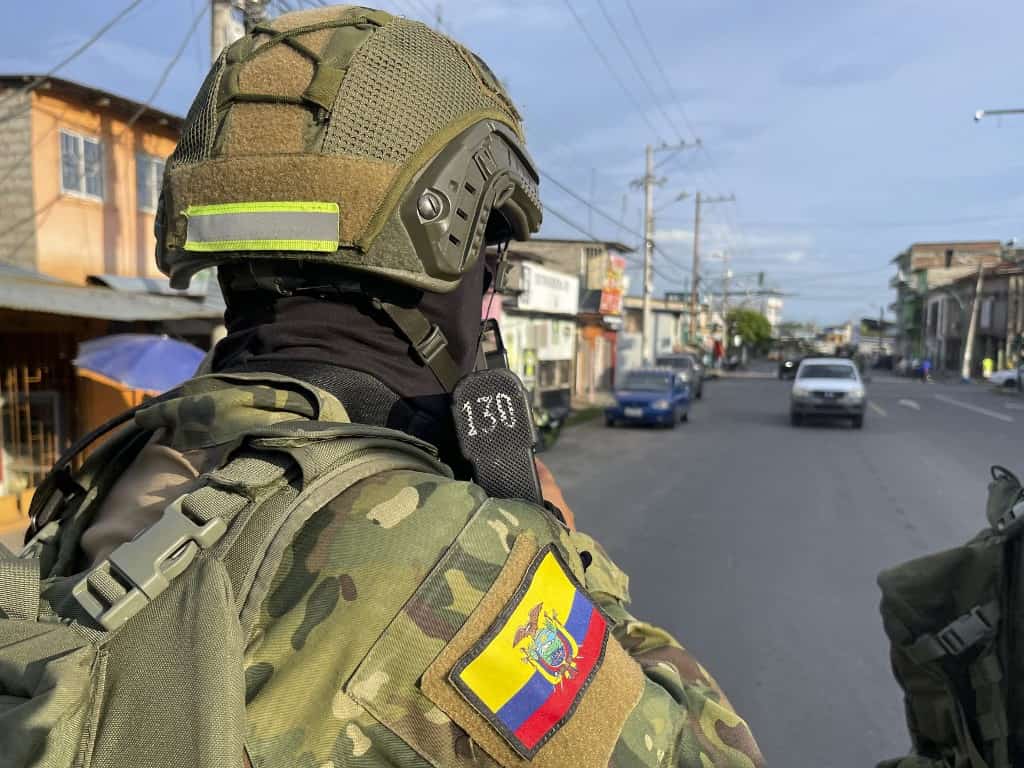Military convoys of heavily-armed soldiers are rumbling through the streets of the Ecuadorian port town of Esmeraldas. The trucks carry more than 100 soldiers wearing bullet-proof vests, trying to root out drug gangs.
This town, situated in the northern part of the country, near the border with Colombia, has been living under a state of emergency for almost two months. The government declared this state of emergency in response to what they call terrorist acts by powerful drug trafficking gangs.
Esmeraldas, a city of 200,000 and the capital of the province of the same name, is considered a stronghold for crime gangs. On a recent raid, one suspect is handcuffed. He is believed to belong to a feared gang called the Tiguerones.
Gang members live by blending in with regular everyday people, according to police colonel Julio César Vásquez. A young detainee with long hair and a tiger tattooed on his ankle is one of more than 900 people arrested around the country since the state of emergency was declared, according to the interior ministry.
State of Emergency
President Guillermo Lasso declared the emergency in Esmeraldas on March 3, acting because of its proximity to Colombia, the world’s top producer of cocaine. A month later, he extended it to other troubled regions of Ecuador and started letting people carry guns for self-defense. “We have a common enemy: delinquency, drug trafficking, and organized crime,” the president said at the time.
But the state of emergency has not made Esmeraldas much safer. On April 11, a group of some 30 assailants killed nine fishermen in an attack that authorities said stemmed from a gang turf war. Police say that in Esmeraldas, the homicide rate is up seven percent so far this year.
Ecuador is located between Colombia and Peru, the world’s two largest producers of cocaine, much of which is sent to the United States and Europe from Ecuadorian ports, principally Guayaquil. Consequently, Ecuador has seen a recent rise in violence and murders related to drug trafficking. Its murder rate almost doubled from 14 per 100,000 citizens in 2021 to 25 a year later.
People are afraid
Despite all the soldiers deployed in Esmeraldas, people are afraid. Many shops are locked shut, and some hotels and big businesses have been put up for sale. “The gangs, all the crime, we cannot work freely. You hear people say they are being extorted,” said Jofre Mancillo, who runs a warehouse. “There are no guarantees to keep working.”
The situation in Esmeraldas is indicative of the larger issue that Ecuador is facing in its fight against drug trafficking and organized crime. While the country has made significant strides in recent years in terms of seizing cocaine and other illicit drugs, it has also seen a rise in violence and murders related to drug trafficking.
The country’s strategic location between Colombia and Peru, the world’s two largest producers of cocaine, has made it a prime target for drug trafficking organizations.
President Guillermo Lasso’s declaration of a state of emergency in Esmeraldas and other troubled regions of the country was a clear indication of the severity of the situation. The move allowed for the deployment of military and police forces to combat the gangs and drug traffickers. However, as the recent attack on the fishermen shows, the situation remains dire.
Despite the presence of soldiers and police officers, residents of Esmeraldas continue to live in fear. Many businesses have closed their doors, and some hotels and other establishments have been put up for sale. The lack of safety and security has made it difficult for people to go about their daily lives, and there are no guarantees that the situation will improve anytime soon.
The fight against drug trafficking and organized crime is a complex and multifaceted one. It requires not only the deployment of military and police forces but also the implementation of long-term solutions that address the root causes of the problem.
These may include measures such as increased investment in education, job creation, and social programs that help people break free from the cycle of poverty and violence.
In the case of Ecuador, it is also important to address the issue of corruption, which has long been a major problem in the country. Corruption within the police force and other government institutions can undermine efforts to combat drug trafficking and organized crime, as it allows criminal organizations to operate with impunity
Final Thoughts
Overall, the situation in Esmeraldas is a stark reminder of the challenges that Ecuador and other countries in the region face in their fight against drug trafficking and organized crime.
While there are no easy solutions to this complex problem, it is clear that a coordinated and sustained effort is needed to address the root causes of the issue and provide people with the security and safety they need to live their lives free from fear.
.

